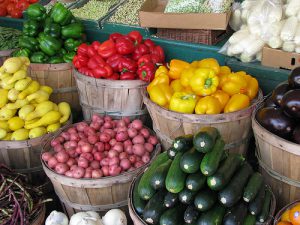 Allelopathy is understood to mean the influence exerted by vegetable products (fruits) on other plants or plants of the same species through the gases they give off, such as carbon dioxide (CO2), ethylene (ethene, C2H4) and aromatic substances, which reach their peak in particular at the climacteric (=time of maximum respiration). A concentration of 0.02% of ethylene in air may accelerate the ripening process by 4 – 10 times. It is therefore essential that unripe fruit at the preclimacteric stage is not stowed together with ripe fruit. If one item of fruit begins to excrete ethylene, a whole cargo of fruit may begin the increase in respiration associated with the climacteric. Allelopathy is not only observable in fruits of the same species, but also when different species are stored together. For example, apples excrete large amounts of ethylene, which may cause potatoes to sprout prematurely. Cucumbers turn yellow on exposure to ethylene from apples or tomatoes. The reason for this is that the fruit and vegetable species produce different amounts of ethylene and exhibit different levels of sensitivity to other ethylene producers, as is clear from the tables below. On the other hand, allelopathy may be used to advantage in ripening warehouses to bring about ripening at the desired time by exposure to ethylene.
Allelopathy is understood to mean the influence exerted by vegetable products (fruits) on other plants or plants of the same species through the gases they give off, such as carbon dioxide (CO2), ethylene (ethene, C2H4) and aromatic substances, which reach their peak in particular at the climacteric (=time of maximum respiration). A concentration of 0.02% of ethylene in air may accelerate the ripening process by 4 – 10 times. It is therefore essential that unripe fruit at the preclimacteric stage is not stowed together with ripe fruit. If one item of fruit begins to excrete ethylene, a whole cargo of fruit may begin the increase in respiration associated with the climacteric. Allelopathy is not only observable in fruits of the same species, but also when different species are stored together. For example, apples excrete large amounts of ethylene, which may cause potatoes to sprout prematurely. Cucumbers turn yellow on exposure to ethylene from apples or tomatoes. The reason for this is that the fruit and vegetable species produce different amounts of ethylene and exhibit different levels of sensitivity to other ethylene producers, as is clear from the tables below. On the other hand, allelopathy may be used to advantage in ripening warehouses to bring about ripening at the desired time by exposure to ethylene.
| Ethylene production rates [ µ l/(kg*h) ] |
Products |
| Zero: 0 | Chinese artichoke, Japanese radish, prickly pear, Florence fennel, cassava, pak-choi cabbage, cranberry, black salsify |
| Very low: 0.01 – 0.1 | Pineapple, artichoke, cauliflower, broccoli, watercress, mushroom, chicory, Chinese cabbage, date, endive, pea, Jerusalem artichoke, grapefruit, curly kale, ginger, carrot, potato, cherry, garlic, celeriac, kohlrabi, lime, sweetcorn, mandarin, horseradish, orange, parsnip, parsley root, chanterelle, leek, radish, rhubarb, Brussels sprout, beetroot, red cabbage, turnip, green cabbage, asparagus, spinach, rutabaga, celery, sweet potato, tangerine, taro, grape, white cabbage, lemon, onion |
| Low: 0.1 – 1.0 | Winter cherry, aubergine, egg-plant, berries, bitter squirting cucumber, Seville orange, bean, clementine, persimmon, iceberg lettuce, baby sweetcorn, pomegranate, guava, cucumber, starfruit, kiwifruit, coconut, cabbage lettuce, kumquat, pumpkin, limequat, olive, sweet pepper, chili pepper, quince, garden radish, satsuma, watermelon, courgette, zucchini |
| Moderate: 1.0 – 10.0 | Banana, fig, feijoa, honeydew melon, Jack fruit, lychee, mango, mangosteen, plum, tomato |
| High: 10.0 – 100.0 | Apricot, avocado, tamarillo, pear, papaya, peach/nectarine |
| Very high: > 100.0 | Apple, cherimoya, passion fruit |
Table 1: Ethylene production rates of various products
| Ethylene sensitivity | Products |
| Zero | Seville orange, Chinese artichoke, clementine, fennel, kumquat, pak-choi cabbage, chanterelle, cranberry, garden radish, satsuma |
| Low | Pineapple, winter cherry, artichoke, aubergine, egg-plant, berries, bitter squirting cucumber, date, Jerusalem artichoke, fig, feijoa, baby sweetcorn, pomegranate, ginger, prickly pear, starfruit, carrot, cherry, garlic, celeriac, coconut, pumpkin, sweetcorn, cassava, horseradish, sweet pepper, parsnip, chili pepper, parsley root, radish, rhubarb, beetroot, turnip, black salsify, rutabaga, sweet potato, taro, grape, watermelon, onion (dry) |
| Moderate | Tamarillo, bean, mushroom, endive, pea, Jack fruit, grapefruit, guava, potato, cabbage lettuce, lime, lychee, mandarin, olive, orange, leek, asparagus, celery, tangerine, lemon, courgette, zucchini, onion (green) |
| High | Apple, apricot, avocado, banana, pear, cauliflower, broccoli, watercress, cherimoya, chicory, Chinese cabbage, persimmon, iceberg lettuce, curly kale, cucumber, honeydew melon, kiwifruit, mango, mangosteen, papaya, passion fruit, peach, plum, quince, Brussels sprout, red cabbage, spinach, tomato, white cabbage, savoy cabbage |




